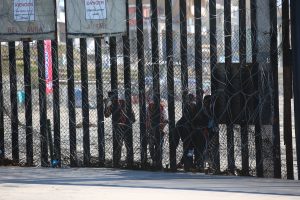Since 2012, there has been a steady increase in the number of Chinese nationals seeking asylum, totaling over 850,000. The United States is the leading host country, with approximately 88,000 Chinese asylum seekers and another 66,000 with refugee status. Recently, the surge in the number of Chinese migrants apprehended at the Mexico-U.S. border has reached nearly 10,000 since last October, marking the highest figure on record.
Traversing across eight Latin American countries to reach the United States’ southern border, these migrants typically start their journey in Ecuador, one of the few Latin America countries offering visa-free travel for Chinese citizens. From there, they proceed to Necoclí, a town in Colombia’s northern coast that serves as a launchpad to cross the Darién Gap – a treacherous route of dense forest and swampy terrain that connects Central and South America. Throughout their journey, these migrants face constant risks of robbery, abuse, and even death.
To undertake this journey, Chinese migrants reportedly spend around $5,000 to $7,000 for self-guided trips, while others pay smugglers fees of up to $35,000, or three times what migrants from Central or South America typically pay. The ability to afford such high fees suggests that while some migrants come from working-class backgrounds, many are from the middle class. Among those apprehended are small business owners, educators, and even a former finance student in Australia. The difficulty of obtaining a U.S. visa is often cited as a reason for undertaking such a costly and dangerous journey.
The Chinese exodus is driven by a combination of economic uncertainties and limited personal freedoms. China’s slowing economic growth, exacerbated by almost three-years of strict COVID-19 restrictions, has prompted many individuals to seek opportunities abroad. The urban youth unemployment rate recently reached a record high of 20.4 percent, four times the national unemployment rate, leaving recent graduates with limited prospects. Small business owners have also suffered as their businesses struggled to survive during periods of lockdowns and weak consumer demand. Declining social and religious freedoms are the other leading factors of migration, as the crackdown on LGBTQ rights, feminist movements, and religious practices among others continues.
润学 (runxue, “run philosophy”) is a popular internet slang term that emerged during the pandemic, referring to the desire and enquiry to leave China and immigrate abroad. At the peak of China’s zero COVID policy in early April of the previous year, internet searches for the word “immigration” increased four-fold and searches for the phrase “Canada immigration conditions” increased by a factor of 28.
While some individuals can immigrate through skilled migration or investment-based citizenship programs, others take the irregular route by seeking asylum. 走线 (zouxian, “walking the route”) is an internet term that refer to the act of irregular migration to the U.S. via Latin America by foot. A search for this term on Douyin, the Chinese version of TikTok, yields numerous results of users sharing their experiences and tips related to making this journey.
With an estimated diaspora population of 60 million people, China is no stranger to large-scale emigration. Unlike past waves of Chinese migrants, however, these new waves of migrants are better equipped with capital and knowledge about the outside world through accessible channels like social media. They not only seek improved living conditions but also desire greater autonomy and liberty, turning to irregular means as a last resort. Although irregular migrants constitute a small portion of the overall exodus of Chinese migrants from various socioeconomic backgrounds, they have become the fastest growing migrant group arriving at the U.S. southern border in the past six months.
The rapid increase in irregular migration from the world’s second largest economy contradicts China’s desired domestic and international image. Domestically, the concept of the “Chinese dream” encourages citizens to pursue their personal aspirations alongside collective prosperity and national rejuvenation. However, after enduring strict lockdown measures for three years, which resulted in substantial economic and mental health burdens, many individuals have become disillusioned with this vision.
On the international stage, China has invested trillions of dollars in its ambitious Belt and Road Initiative, seeking to solidify its position as a rising power and present an alternative to the U.S.-led world order. However, the presence of tens of thousands of disillusioned Chinese migrants at the U.S. border suggests that China still has some distance to go in realizing its global ambitions.
It’s important to note that not all extra-continental migrants who travel to Latin America continue their journey northward. Some Chinese migrants, deterred by the high barriers of entry in the United States and Canada, directly seek refuge in South American countries like Ecuador, where residency requirements are more lenient. Others may abandon their immediate plans to head north due to the high risks and insurmountable expenses involved, choosing to remain in their transit destinations.
Amid economic uncertainty and limited space for individual freedoms, Chinese citizens are increasingly “voting with their feet” by seeking opportunities abroad. With the vast amount of information accessible through the web and social media, the Chinese exodus is likely to persist and expand beyond mainstream immigration destinations.

































